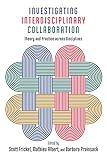Investigating Interdisciplinary Collaboration : Theory and Practice across Disciplines / Scott Frickel, Mathieu Albert, Barbara Prainsack.
Material type: TextSeries: The American CampusPublisher: New Brunswick, NJ : Rutgers University Press, [2016]Copyright date: ©2016Description: 1 online resource (249 p.) : 10 figures, 7 tablesContent type:
TextSeries: The American CampusPublisher: New Brunswick, NJ : Rutgers University Press, [2016]Copyright date: ©2016Description: 1 online resource (249 p.) : 10 figures, 7 tablesContent type: - 9780813585888
- 9780813585918
- 001 23
- BD255 .I65 2017
- BD255.I65 2016
- online - DeGruyter
- Issued also in print.
| Item type | Current library | Call number | URL | Status | Notes | Barcode | |
|---|---|---|---|---|---|---|---|
 eBook
eBook
|
Biblioteca "Angelicum" Pont. Univ. S.Tommaso d'Aquino Nuvola online | online - DeGruyter (Browse shelf(Opens below)) | Online access | Not for loan (Accesso limitato) | Accesso per gli utenti autorizzati / Access for authorized users | (dgr)9780813585918 |
Frontmatter -- Contents -- Acknowledgments -- Prologue: The Messiness of Real-World Solutions -- Introduction: Investigating Interdisciplinarities -- Part I. Interdisciplinary Cultures and Careers -- 1. New Directions, New Challenges: Trials and Tribulations of Interdisciplinary Research -- 2. The Frictions of Interdisciplinarity: The Case of the Wisconsin Institutes for Discovery -- 3. Epistemic Cultures of Collaboration: Coherence and Ambiguity in Interdisciplinarity -- 4. Interdisciplinary Fantasy: Social Scientists and Humanities Scholars Working in Faculties of Medicine -- Part II. Disciplines and Interdisciplinarity -- 5. Some Dark Sides of Interdisciplinarity: The Case of Behavior Genetics -- 6. A Dynamic, Multidimensional Approach to Knowledge Production -- 7. Disciplinary and Interdisciplinary Change in Six Social Sciences: A Longitudinal Comparison -- Part III. Changing Context of Interdisciplinary Research -- 8. "An Electro-Historical Focus with Real Interdisciplinary Appeal": Interdisciplinarity at Vietnam-Era Stanford -- 9. Interdisciplinarity Reloaded? Drawing Lessons from "Citizen Science" -- 10. One Medicine? Advocating (Inter)disciplinarity at the Interfaces of Animal Health, Human Health, and the Environment -- Notes on Contributors -- Index
restricted access online access with authorization star
http://purl.org/coar/access_right/c_16ec
Interdisciplinarity has become a buzzword in academia, as research universities funnel their financial resources toward collaborations between faculty in different disciplines. In theory, interdisciplinary collaboration breaks down artificial divisions between different departments, allowing more innovative and sophisticated research to flourish. But does it actually work this way in practice? Investigating Interdisciplinary Collaboration puts the common beliefs about such research to the test, using empirical data gathered by scholars from the United States, Canada, and Great Britain. The book's contributors critically interrogate the assumptions underlying the fervor for interdisciplinarity. Their attentive scholarship reveals how, for all its potential benefits, interdisciplinary collaboration is neither immune to academia's status hierarchies, nor a simple antidote to the alleged shortcomings of disciplinary study. Chapter 10 is available Open Access here (https://www.ncbi.nlm.nih.gov/books/NBK395883)
Issued also in print.
Mode of access: Internet via World Wide Web.
In English.
Description based on online resource; title from PDF title page (publisher's Web site, viewed 07. Jan 2021)


